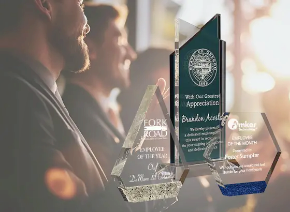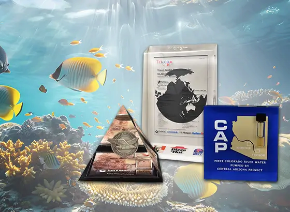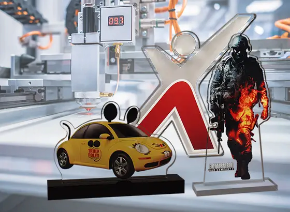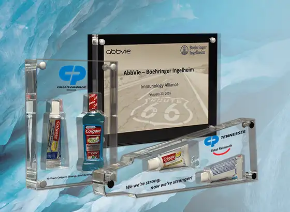
When it comes to recognizing your team for a job well done, there are a lot of choices for fine corporate awards. The three most common mediums for business recognition trophies are crystal, glass, and acrylic. All three are quality options, look great, and have similar visual characteristics. But one product stands out as the best stress-free choice for corporate recognition and our intention with this article is to review the pros and cons of each to help you make an informed purchasing decision.
First let’s review each of the mediums to understand their chemical composition and how each differs.
 What is crystal?
What is crystal?
It’s lead that gives crystal its dazzling weight and sparkle, something that both glass and acrylic will never be able to match. Many of the crystal awards you will find at trophy shops around the world are made in Chinese factories and at the time this article was written there is no information as to the percentage of lead oxide in the chemical composition of the pieces offered.
Why is this important? The primary reason is that for glass to be considered crystal, it must contain at least 7% lead oxide and truly high quality crystal must contain at least 24%. And as a comparison Swarovski crystal which is considered to be one of the best in the world contains 30% lead oxide. With a 23% point swing in minimum quality to high quality crystal, it’s important to ask your trophy shop about the actual quality of the crystal awards you’re paying a premium for.
 What is glass?
What is glass?
Technically glass is made from opaque sand exposed to extreme heat. However today's glass is a composition of sand, recycled glass, calcium carbonate, and sodium carbonate. The calcium carbonate is used primarily for reducing the melting point (an energy saver) and the sodium carbonate (limestone) is added for strength. Together they form a compound called soda-lime-silica glass which is what you’re exposed to everyday in the windows of your home, lightbulbs, and in the context of what we are discussing, glass trophies. One of the unique features of glass as a substrate for trophies is that since much of the glass comes from recycled materials, it can be tinted with colors like jade, blue, and red.
Glass trophies are often made by pouring molten glass into a mold or cutting shapes from thick flat glass sheets which are then diamond polished on the edges to create unique bevels that attract light and accentuate their shape. Glass often costs less than crystal with a similar appearance.
 What is acrylic?
What is acrylic?
Acrylic, or often called Lucite® (a trade name), is made up of two compounds – a clear liquid monomer and a powdered polymer that looks similar to high quality white baking flour. Mixed together, the compounds form a pourable liquid that looks much like cake batter. The liquid compound can be poured into shaped molds or poured flat to specific thicknesses to create fabricatable sheet stock. Applying constant heat and pressure causes a chemical reaction called polymerization to happen whereby both the monomer and polymer combine to create crystalline chains of molecules that clarifies and hardens the material.
Lucite® sheet stock and molded acrylic blocks can be fabricated much like wood by cutting, shaping, and polishing it to a higher clarity level than glass and sometimes crystal depending on its level of quality. Lucite® also offers the flexibility to cast items inside to protect and display them in what we call an acrylic embedment.
Secondly, let’s take a look at the different decoration methods trophy manufacturers use to personalize crystal, glass and acrylic.
There are three primary decoration methods used in awards manufacturing to decorate crystal, glass, and acrylic. Each comes with its own set of benefits and most importantly appearance on the trophy. You can read more about decoration methods in our article ‘The Mark of Excellence’ which goes more in depth into the history of engraving techniques and each of the processes below.

Laser Engraving
Since the late 1980’s, laser engraving has grown to be a must-have in just about every trophy shop in the world. Crystal, glass, and cast acrylic can be laser engraved – each with a slightly different look which should be considered when ordering awards. Pictured above is an image of a Trotec® Speedy 300 Flex laser engraver.
Laser Engraved Crystal & Glass
Crystal and glass can both be laser engraved with the proper power, focal length, and speed settings to fracture the substrates, thus changing the engraved area from clear to a frosted light gray look. Note that we refer to the term fracture which is exactly what happens when focused laser light applies heat to the surface. Though the substrate is still stable, the fractured look on the surface of crystal and glass does not produce the high quality frosted appearance that sand etching produces.
Laser Engraved Acrylic
Cast acrylic is best engraved using a laser engraver. With proper power and speed settings, lasers can be set to lightly frost or deeply etch the surface of acrylic. Both techniques create the high quality look of exquisite sand etched crystal with the simplicity of laser engraving.
The process of laser engraving deeply into the acrylic creates a cavity which can be color filled to add accent colors to the engraved area. Highlighting a name or a logo in color can change the perceived value of the award with very minimal cost.

Ultraviolet Direct Printing
Recently the process of direct printing has been changing the look of trophies and awards around the world. Direct printing is the equivalent of a very complex inkjet printer configured with a special ink that when exposed to ultraviolet light hardens on the surface. Though UV direct printing is most commonly used on acrylic, both glass and crystal can be printed with some limitations. Pictured above is an image of a Mimaki ultraviolet printing machine.
UV Printing Crystal & Glass
Both these substrates are capable of being directly printed with ultraviolet inks. However the two substrates have different chemical compositions that require slightly different techniques to achieve decent results.
First, crystal is a more porous material which naturally allows the ink to bond to the surface better than glass with the proper pretreatment. However, as we discussed earlier, crystal has an additive (lead oxide) which helps it to refract light. Since light is required to cure UV inks, refraction can and often does damage very costly print heads. It takes special care to print crystal in order to eliminate refractive light that may prematurely clog or even destroy a print head. Special care relates to added time and money to decorate an already premium quality product.
Glass has its own special characteristics that must be taken into account when directly printing on its surface. Like crystal, glass is slightly porous and is susceptible to absorbing debris which may prohibit proper adhesion of the ultraviolet inks. A special wipe on primer is required prior to direct printing glass which creates an adhesion promoting layer between the flat surface and ultraviolet inkjet inks.
UV Printing on Acrylic
For indoor applications, traditional cast acrylics print exceptionally well without any pretreatment or additives. Full color printing on acrylic can be an excellent way to add a colorful accent or represent a corporate brand in full color on a trophy or award. For ultraviolet printing applications on awards that may be exposed to direct sunlight, specially coated acrylic sheets like those manufactured by Optix® offer an added benefit of superior adhesion and should be considered.

Sand Etching
Primarily used for crystal and glass decoration, sand etching is a detailed process involving the creation of a blasting mask that allows for a spray of low pressure aluminum oxide to gracefully etch the smooth surface. Though sand etching can produce unique results on acrylics, many times similar results can be achieved with laser or ultraviolet technology.
Sand Etching Crystal and Glass
Our recommendation for any discerning buyer that wants a truly exquisite crystal or glass award is to request sand etching. Many trophy shops around the world have at the cost of quality opted to use laser engraving technology to mark crystal and glass which as we discussed previously simply fractures the glass. Though sand etching is significantly more costly, the look is second to none.
There are a few ways sand etching is achieved on crystal and glass trophies. The simplest is the combination of laser technology and sand etching. By simply placing a laserable mask material on the smooth surface then laser engraving the image through the mask to the glass or crystal – the award can be covered with masking tape to protect the exposed areas and sand etched in a blasting unit.
The traditional way of sand etching requires the creation of a film positive, a photosensitive masking material, exposure to light, and a wash out procedure to create a sand etching mask that can be applied to the surface. Once applied, the award is taped to protect any exposed surfaces and etched in a blasting unit to remove and create a beautiful frosted gray appearance.
Sand Etching Acrylic
As mentioned above sand etched acrylic is primarily used for accenting unique deal toys or other awards by adding a frosted edge or background. Much like mentioned above, in order to etch acrylic a protective layer must be applied to any surface areas that should not be exposed to the stream of aluminum oxide. Here is a great example of how frosting a deal toy award can add a layer of depth to highlight color printing or embedded objects in Lucite®.
Finally let’s take a look at an important purchasing factor – the cost of shipping and handling of crystal, glass and acrylic awards.
The cost of shipping and handling over the years has continued to increase and can have a huge impact on award budgets. Two important issues to address are the actual cost of shipping and the cost of breakage that can occur when not packaged well.
 Shipping Costs
Shipping Costs
It’s important to note that over the past decade (2012-2022) both UPS and FedEx ground rates have increased by an average of 74.9% and air freight rates a similar 75% as reported by Lojistic.com. Taking that into account, there are two primary factors that determine shipping costs – weight (physical) and dimensional weight (package size).
Crystal and glass are notorious for susceptibility to breakage in shipping, which requires additional packaging to protect the items. Additional packaging relates to larger packages and added dimensional weight charges. Acrylic awards on the other hand are extremely stable and as much as 10 times more shatter resistant than glass or crystal – thus requiring less packaging and smaller box sizes.
As mentioned above crystal with its lead additives are significantly heavier than their counterpart glass. But, when either are compared to acrylic which is approximately 50% of the weight of glass – the differences in costs of shipping are significant. A good thing to note is that US Acrylic Awards offers free shipping on all orders over $200 within the continental United States.
So let’s sum up the pros and cons of the purchasing options of crystal, glass, and acrylic awards.
 Crystal Awards
Crystal Awards
Pros include that crystal is definitely a beautiful material with a lot of preconfigured shape options that are heavier, more sparkly, and can be sand etched with a fine frosted gray finish. Its weight alone provides the recipient with a feel of elegance, and as a corporate award crystal has been one of the most commonly chosen substrates to represent quality for decades.
Cons include that most of the crystal awards today are made in Chinese factories with no evidence that the product meets or exceeds the minimum 7% standard of lead oxide to be considered true crystal. For the personalization to look great, it must be sand etched which is often the most costly option when compared to laser and direct printing. Direct printing is an option, but requires special handling to ensure the personalization is durable. Crystal is the most fragile of the three and is more subject to damage like chipping and cracking. Its fragility and added weight requires additional packaging driving up delivery costs.
 Glass Awards
Glass Awards
Pros include that glass is traditionally a beautiful material that when finished well can achieve a similar look to crystal. There are multiple sizes and shapes of glass trophies to choose from, along with color options like clear, jade, blue, and red. Glass when sand etched looks amazing and when etched deeply can be color filled. Glass is a great alternative to costly crystal awards and can keep corporate award budgets in check.
Cons include that glass though laser engravable looks better when sand etched since laser engraving will create a fractured muddy look on glass. Much like crystal, direct printing is an option, but it requires a special primer treatment to ensure its durability. Its weight and fragility can add additional costs to the shipping charges in order to protect it from being damaged in transit and for dimensional weight add-ons by carriers like UPS and FedEx.
 Acrylic Awards
Acrylic Awards
Pros include that acrylic is optically clearer even than glass and crystal. As a naturally refractive material acrylic provides a similar look to crystal and glass at a much lower production cost. Since US Acrylic Awards manufactures all of our products in the US inventories are rarely an issue for meeting delivery deadlines. Acrylic can be cut from thick sheet stock or custom cast for a heavier, more elegant corporate award or embedding a corporate achievement directly inside as a showpiece. Acrylic is 50% lighter and has 10 times more impact resistance than glass or crystal thus reducing the requirement for additional packaging and costly delivery costs. Acrylic can be cut to custom shapes to contour corporate or event logos. There are few limits to personalization since laser engraving and ultraviolet direct printing both look amazing or you can get creative with a combination of both for a unique custom look.
As a manufacturer of fine corporate acrylic awards, we may be a bit biased but are confident that acrylic is the ultimate choice for recognition. When we compare crystal, glass, and acrylic – there are no cons to choosing Lucite® for quality, personalization options, and reduced shipping costs.
US Acrylic Awards is an American manufacturer of fine acrylics in Glendale, Arizona offering free design services to help you create unique deal toys, embedments, and awards. Give us a call and let our team add a little sparkle to your recognition program with a stress free buying experience.
Written by noptim… unleash the power







